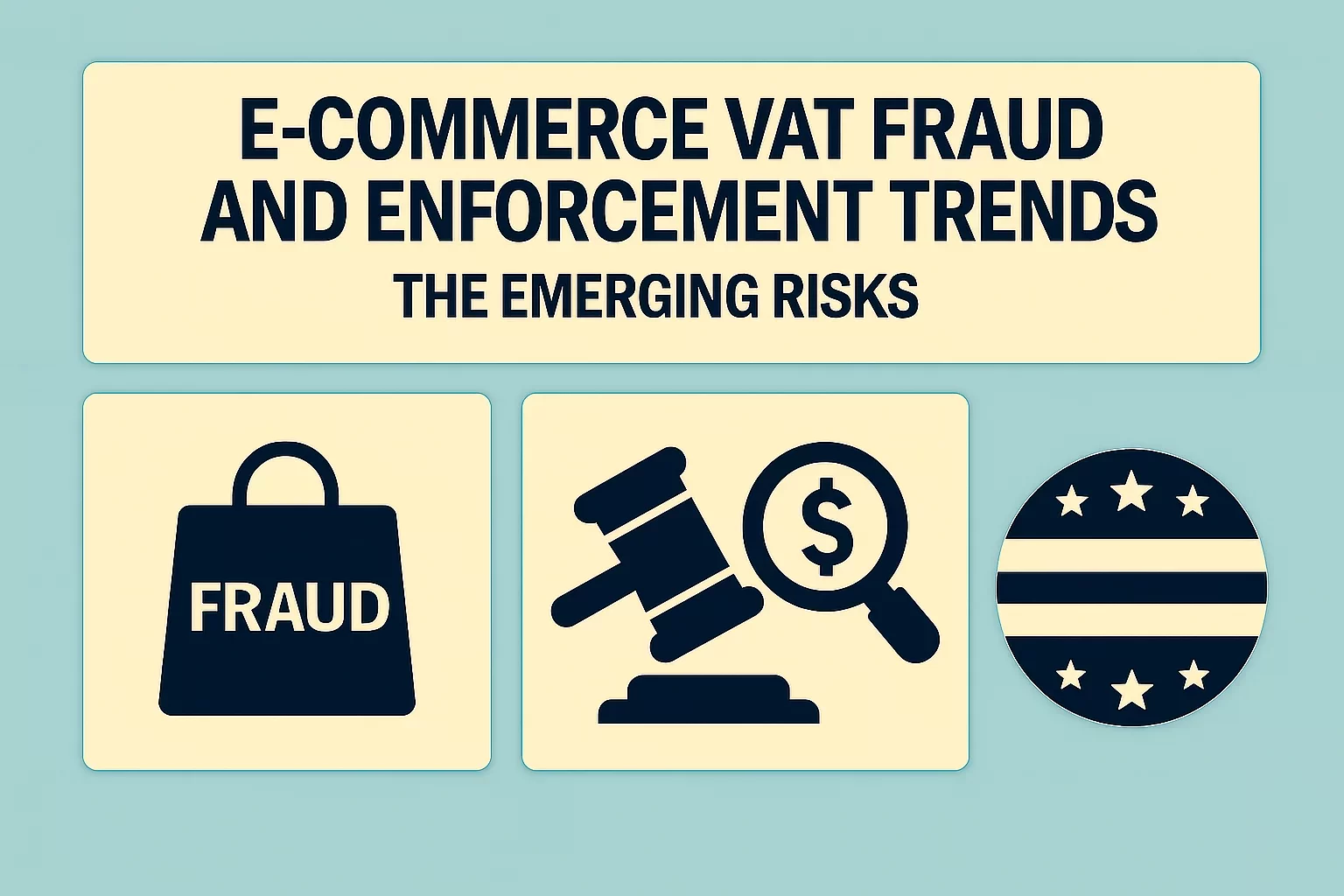E-commerce VAT Fraud and Enforcement Trends
Delve into the latest trends in e-commerce VAT fraud and enforcement, including how authorities are cracking down on non-compliant businesses.
Where there is progress and opportunities, there are people who want to exploit the system, find any loopholes, and ensure financial gains by bending the rules. Therefore, the globalization of retail also opened new avenues for VAT frauds, ranging from carousel schemes to invoice manipulation and rogue marketplace operators.
To address this growing issue, tax authorities worldwide are taking necessary steps to combat fraudsters by updating legal rules and regulations to meet new circumstances, utilizing digital tools, and enhancing cross-border cooperation.
Common VAT Fraud Schemes in E-Commerce
There are several common VAT fraud schemes recognized worldwide in e-commerce. The first, and possibly the most frequent, is carousel fraud, also known as Missing Trader Intra‑Community (MTIC) fraud. The scheme relies on chains of transactions between EU countries that evade VAT by exploiting cross-border exemptions. After the VAT is collected, one of the parties in the chain vanishes, leaving the Tax Authorities without the due VAT.
The second type of fraud refers to invoice fraud schemes, which involve fake or inflated invoices, typically for non-existent goods or services. False or inflated invoices are generally submitted to justify undue VAT refunds. These counterfeit invoices proliferate easily online, often being used within Voice over Internet Protocol (VoIP) services, digital subscriptions, or e-learning platforms.
Another common type of VAT fraud in the e-commerce sector is fraud perpetrated by opaque sellers on online marketplaces. In these situations, goods are frequently imported from foreign countries, where sellers misdeclare goods, underdeclare the value, or fail to register for VAT, taking advantage of low-value import exemptions.
The magnitude of these frauds is considerable. For example, in its 2024 report, the European Public Prosecutor's Office (EPPO) reported that, out of all estimated damage, approximately EUR 13.15 billion is linked to cross-border VAT fraud. Moreover, they distort market competition, undermine honest traders, and drain public revenues.
Policy and Regulatory Developments
When discussing policy and regulatory developments aimed at reducing the maneuvering space for fraudsters to exploit legal loopholes, the 2021 EU E-commerce package is the first to be mentioned. The primary goal of the package was to reform the EU's VAT rules for cross-border online sales within the EU, aiming to simplify procedures and modernize the VAT system.
However, by introducing a EUR 150 threshold for small consignments of goods imported into the EU, it also reduces the possibility for fraudsters to exploit the low-value import exemptions. Nevertheless, it did not neutralize the possibility of VAT fraud. Therefore, the EU is considering further development of this rule.
The VAT in Digital Age (ViDA) initiative is another EU package aimed at further reducing the possibility of VAT fraud and evasion. By mandating real‑time e-invoicing and harmonized Digital Reporting Requirements (DRRs), the EU aims to increase tax transparency and efficiency, thereby ensuring more revenues for the national budgets of EU countries.
On the global scale, the OECD founded the Global Forum on Transparency and Exchange of Information for Tax Purposes in 2000, which was restructured in 2009. The Global Forum addresses issues such as tax evasion, tax havens, offshore financial centers, tax information exchange agreements, double taxation, and money laundering.
Another significant policy developed by the OECD is the Model Rules for Reporting by Platform Operators concerning Sellers in the Sharing and Gig Economy. The list of countries that implemented these rules includes Canada, New Zealand, the UK, and the EU, with its DAC 7 Directive.
Technological Tools in Use
Governments around the world increasingly deploy machine learning and AI to detect anomalies in VAT transactions. For example, more than 100 AI systems are used in the EU, and 26 out of 27 EU countries use AI to ensure compliance.
By utilizing predictive AI models, Austria increased its tax revenues by EUR 185 million in 2023. Poland has been using AI and machine learning models since 2017 to analyze large taxpayer datasets and identify suspicious transactions, resulting in a reduction of the VAT gap from EUR 6.6 billion to EUR 1.7 billion. Italy is considered a leader in using AI to detect tax breaches. In 2022, the VeRa algorithm enabled the Italian Tax Authority to detect over a million high-risk cases and prevent fraud worth EUR 6.8 million.
Furthermore, digital reporting requirements such as i.MAS in Lithuania, SAF-T in France, Portugal, Lithuania, Luxembourg, and Poland, or Spanish Suministro Inmediato de Información (SII) are all additional mechanisms to ensure proper VAT reporting.
E-invoicing is a crucial mechanism for ensuring the accurate and timely reporting of VAT. By mandating structured e-invoices, governments minimize fraud by ensuring that each invoice contains tamper-proof metadata, including the seller's ID, invoice number, and transaction timestamp. While European, Asian, and South American countries have already adopted this solution, the US and some other countries remain reluctant to implement it.
Global Enforcement Moves: Key Case Studies
Some of the most notable cases explaining the scope and magnitude of these frauds include the EPPO's Investigation Admiral, the Australian Taxation Office's (ATO) Operation Protego, and India's Directorate General of GST Intelligence's (DGGI) USD 30 million case.
EPPO’s Investigation Admiral
The Investigation Admiral unveiled the most significant VAT fraud case in the EU's history, with an initial estimated damage of EUR 2.2 billion. From the moment the first results were published, the estimated value of the VAT fraud rose to EUR 2.9 billion.
The investigation led to the discovery of an organized criminal group that operated in 22 EU countries and 10 non-EU countries, including the UK, the US, and China. Additionally, approximately 9,000 legal entities and more than 600 individuals were involved in this scheme, which involved the trade of electronic devices, including mobile phones and tablets.
ATO’s Operation Protego
In 2022, the ATO issued a warning about fraud schemes being promoted through social media and other channels. As part of Operation Protego, the ATO investigated large-scale GST fraud where individuals invented fake businesses, lodged fraudulent Australian Business Number (ABN) applications, and submitted fictitious Business Activity Statements (BAS) to attempt to gain a false GST refund.
Throughout the Operation, the ATO finalized 62 investigations, leading to 112 people being convicted with a range of sentences, including jail time and an order made to restrain property. Additionally, an AUD 300 million was charged in penalties and interest.
DGGI’s USD 30 Million Case
One of the latest investigations conducted by the DGGI unveiled a USD 30 million fraud that included six shell companies with fraudulent invoices, resulting in nearly USD 4.75 million in fraudulently claimed input tax credit. As the investigation revealed, none of the companies had genuine business activities. They were used to engage in circular trading, a method of artificially inflating turnover by routing transactions through multiple companies without the actual movement of goods or services.
Furthermore, four companies, despite having no real commercial activity, had reported receiving goods and services worth several million dollars. The primary individual who orchestrated the transactions was an accountant and statutory auditor who also acted as director in several of the shell companies.
Conclusion
With the expansion of e-commerce and global trade, it is to be expected that the complexity and scale of VAT fraud will also increase. On one side of the battleground are fraudsters that adapt rapidly, exploiting jurisdictional gaps, legal loopholes, and outdated reporting systems. On the other side, tax authorities and international organizations, such as the OECD, develop new systems and policies to close fraud channels.
Nevertheless, the path toward the elimination of these frauds equires continued investment in digital tax infrastructure, stronger intergovernmental data-sharing, and robust legal responses. Fighting e-commerce VAT fraud is no longer a local issue, but a global necessity to preserve public revenue, protect honest competition, and uphold trust in digital trade.
Carousel fraud, also known as Missing Trader Intra-Community (MTIC) fraud, is a scheme where goods are traded between EU countries, and VAT is collected but not remitted because one party in the chain disappears.
AI analyzes large datasets to detect patterns or anomalies, flagging suspicious transactions in real time and enabling faster enforcement responses.
Shell companies are often used to create circular trade schemes or submit false invoices to claim fraudulent input VAT credits.
VAT fraud results in billions of euros in lost tax revenue each year, weakening public budgets and distorting market competition.
Source: European Commission - Fight against VAT fraud, European Commission - VAT Carousel Fraud, UK Government, VATabout - EPPO 2024 Annual Report: Cross-Border VAT Fraud Losses Exceed EUR 13 Billion, EPPO - Investigation Cuba, PwC, Federal Ministry of Finance, VATabout - Operation Admiral 2.0: EPPO Exposes EUR 2.9 Billion EU VAT Fraud Case, Australian Taxation Office, Indian Ministry of Finance, OECD - Designing a National Strategy against Tax Crime


